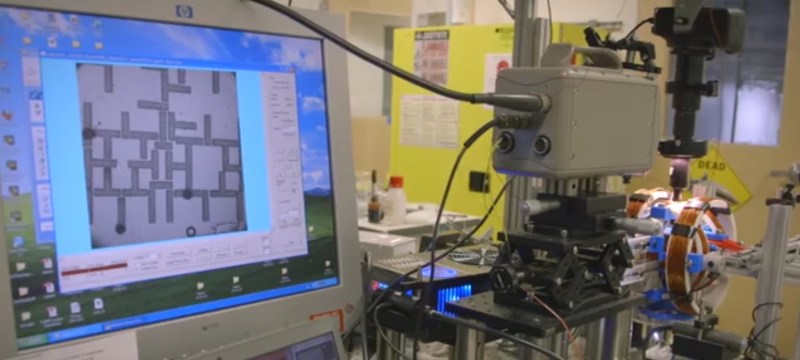On a fundamental level a computer’s processor is composed of logic gates. These gates use the presence of electricity and lack thereof to represent a binary system of ones and zeros. You say “we already know this!” But have you ever considered the idea of using something other than electricity to make binary computations? Well, a team at Stanford University has. They’re using tiny droplets of water and bar magnets to make logic gates.
Their goal is not to manipulate information or to compete with modern ‘electrical’ computers. Instead, they’re aiming to manipulate matter in a logical way. Water droplets are like little bags that can carry an assortment of other molecules making the applications far reaching. In biology for instance, information is exchanged via Action Potentials – which are electrical and chemical spikes. We have the electrical part down. This technology could lead to harnessing the chemical part as well.
Be sure to check out the video below, as they explain their “water computer” in more detail.
Thanks to [PWalsh via Christian Science Monitor] for the tip!















Finally, there’s a practical outlet for my Spacechem addiction.
Bubble memory technology of a different kind.
Thought I’d try to preempt any confusion.
I’ve seen this research before and this actually has nothing to do with computers or logic -The people in the videos are just shit at making analogies. What it actually is, is a method for building microfluidic structures (small structures that work with small amounts of fluid) which can be used for a variety of chemical and biological applications. One example would be for drug testing or DNA work, where precise amounts of different chemicals must me moved about and mixed, as well as undergoing other processes and tests. This is done with small droplets of feromagnetic fluid as the carrying medium, inside the effect of a pair of dual helmholtz coils. The big advancement here is that the droplets allow for easy partitioning of quantities, possibly with less contamination, though I’m sure there are other benefits.
The ‘computer’ analogy comes into play when they make the comparison between how individual droplets are scuttled around from one area to another in a similar manor to how bits (be they 1 or 0) are gated through a digital circuit. Despite the naming conventions used for their structures however, these do not preform logic, or at best do so very poorly, as they were designed for mediating chemical reactions. Microfluidic replacements for electronics do exist, and there are industrial applications for them where electronics would be too dangerous or otherwise unsuitable. There was even once built an extremely simplified (computer) processor that ran on the technology, but this has nothing to do with it.
http://www.newscientist.com/article/dn17730-new-microprocessor-runs-on-thin-air.html#.VY4hePlViko
Good on HaD for going a bit into depth with what this actually is in the second paragraph, but I’d drop the computer/logic gate analogy altogether.
The interesting thing, is that this could probably be very easily replicated at home, using a pair of hand-wound helmholtz coils for X and Y movement, as well as wax paper (which is fairly hydrophobic) and copper stripping upon which the ferofluid can rest. (aluminum tape might also work) I personally can’t wait until the home biohackers get their hands on this tech.
So it’s more like a cnc chemical mixer! You get a etched plate of the chemical solution you want to get composed, and get it composed by droplets!
Pretty much. Only difference here is being able to move from spot to spot.
Thank you for your 2 cents. It actually helped reduce my confusion on this. Truly awesome project!
Still on Windows XP…
A big artists will make a masterpiece using only a piece of sh.t. A world class engineer will make incredible things with some wire and yes with a XP computer. Game of Thrones is written on DOS based wordstar 4.0. I know guys, who writes incredible codes in notepad and midnight commander, at a rate of 2k per day.
http://www.i-programmer.info/news/112-theory/4071-a-crab-based-computer.html